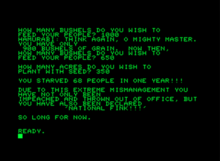Our website is made possible by displaying online advertisements to our visitors.
Please consider supporting us by disabling your ad blocker.
Hamurabi (video game)
| Hamurabi | |
|---|---|
 Screenshot of gameplay | |
| Designer(s) | Doug Dyment |
| Platform(s) | PDP-8, personal computer |
| Release |
|
| Genre(s) | Strategy game, text-based game |
| Mode(s) | Single-player |
Hamurabi is a text-based strategy video game of land and resource management. It was first developed under the name King of Sumeria or The Sumer Game by Doug Dyment in 1968 at Digital Equipment Corporation as a computer game for fellow employee Richard Merrill's newly invented FOCAL programming language.
The game consists of ten rounds wherein the player, as the ancient Babylonian king Hammurabi, manages how much of their grain to spend on crops for the next round, feeding their people, and purchasing additional land, while dealing with random variations in crop yields and plagues. The Sumer Game was inspired by The Sumerian Game, a much more in-depth text-based economic simulation intended for children, developed from 1964 to 1966 by designer and elementary school teacher Mabel Addis and IBM programmer William McKay.
Multiple versions of the game were created for the FOCAL language, but around 1971 David H. Ahl ported it to DEC BASIC and in 1973 published it in 101 BASIC Computer Games. This was later republished in Microsoft BASIC form in 1978's BASIC Computer Games. His expanded version of the game, titled Hamurabi, quickly became the more prominent version due to the popularity of both the book and the programming language. Hamurabi influenced many later strategy and simulation games and is also an antecedent to the city-building genre.
Previous Page Next Page


